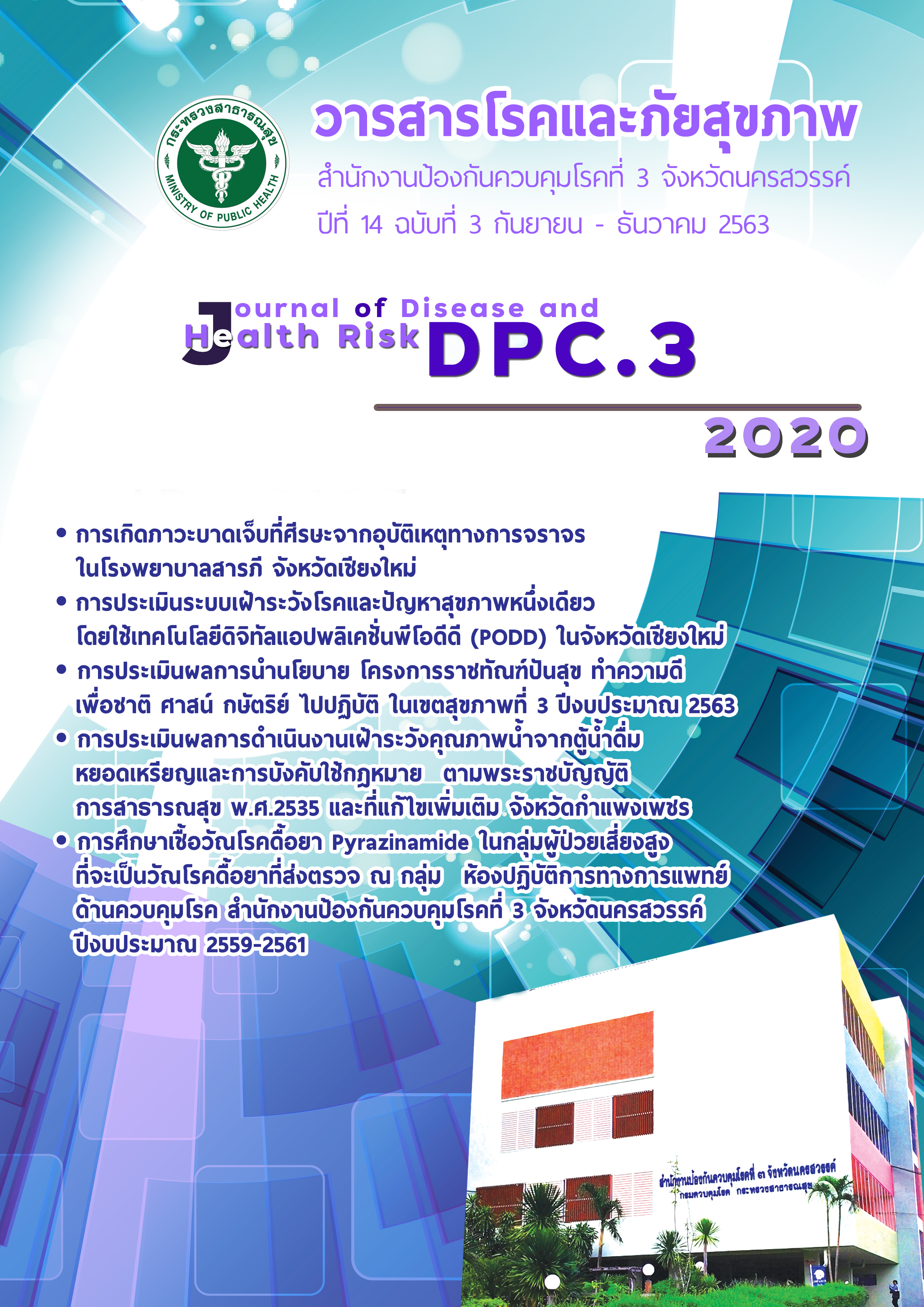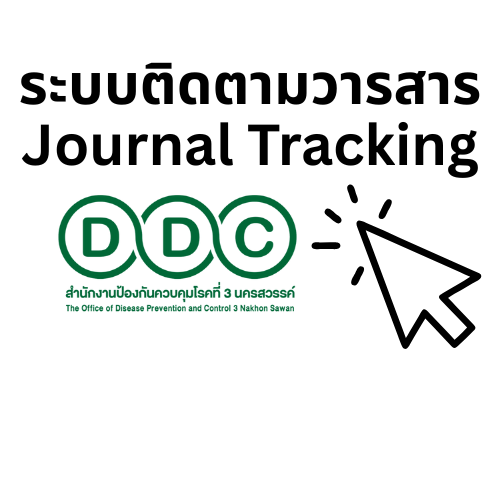การศึกษาเชื้อวัณโรคดื้อยา Pyrazinamide ในกลุ่มผู้ป่วยเสี่ยงสูงที่จะเป็นวัณโรคดื้อยาที่ส่งตรวจ ณ กลุ่มห้องปฏิบัติการทางการแพทย์ด้านควบคุมโรค สำนักงานป้องกันควบคุมโรคที่ 3 จังหวัดนครสวรรค์ ปีงบประมาณ 2559-2561
คำสำคัญ:
Pyrazinamide, วัณโรคดื้อยาหลายขนาน, ผู้ป่วยเสี่ยงสูงบทคัดย่อ
การวิจัยครั้งนี้มีวัตถุประสงค์เพื่อศึกษาการดื้อยา Pyrazinamide (PZA) ในกลุ่มผู้ป่วยเสี่ยงสูงที่จะเป็นวัณโรคดื้อยา 3 กลุ่ม ได้แก่ ผู้ป่วยประเภท Re-treatment, On-treatment และ Pre-treatment จากตัวอย่างของผู้ป่วยกลุ่มเสี่ยงสูงทั้งสิ้น จำนวน 371 ตัวอย่าง ซึ่งทดสอบความไวต่อยาในห้องปฏิบัติการวัณโรค สำนักงานป้องกันควบคุมโรคที่ 3 จังหวัดนครสวรรค์ ช่วงปีงบประมาณ 2559-2561 พบอัตราการดื้อยา PZA ในกลุ่ม On-treatment สูงที่สุด (ร้อยละ 15.9) รองลงมา คือ กลุ่ม Re-treatment (ร้อยละ 11.0) และกลุ่ม Pre-treatment (ร้อยละ 8.2) ตามลำดับ แต่ทั้งนี้ไม่พบความแตกต่างทางสถิติ (P-value = 0.186) อัตราการดื้อยา PZA ในกลุ่ม MDR-TB พบสูงถึงร้อยละ 32.4 ในขณะที่กลุ่มที่ไวต่อยาแบบ Pan-susceptible พบอัตราการดื้อยา PZA ร้อยละ 6.6 การเปรียบเทียบผลการทดสอบความไวต่อยา PZA ร่วมกับยาวัณโรคแนวที่ 1 (First-line drugs: FLDs) พบว่าผลการทดสอบความไวต่อยา PZA มีความสัมพันธ์อย่างมีนัยสำคัญทางสถิติ (P-value < 0.05) กับผลทดสอบความไวต่อยา FLDs ทั้ง 4 ชนิด ได้แก่ Streptomycin (SM), Isoniazid (INH), Rifampicin (RIF) และ Ethambutol (EMB) โดยเชื้อที่ดื้อยา EMB มีอัตราการดื้อยา PZA สูงที่สุด ร้อยละ 80.0 ส่วนเชื้อดื้อยา RIF, SM และ INH พบอัตราการดื้อยา PZA ร้อยละ 28.9, 28.6 และ 27.4 ตามลำดับ การทดสอบความไวต่อยา PZA ควรมีการตรวจในกลุ่มผู้ป่วยเสี่ยงสูงทั้ง 3 ประเภท โดยเฉพาะในกลุ่ม On-treatment เนื่องจากพบร้อยละการดื้อแบบ MDR มากที่สุด และพบอัตราการดื้อยา PZA สูง
เอกสารอ้างอิง
World Health Organization. Global tuberculo-sis report 2019. Geneva, Switzerland: WHO; 2019.
World Health Organization. Guidelines for treatment of drug-susceptible tuberculosis and patient care. Geneva, Switzerland: WHO; 2017.
สำนักวัณโรค กรมควบคุมโรค. แนวทางการรักษาผู้ป่ วยวัณโรคดื้อยาหลายขนาน ด้วยสูตรยาระยะสั้น 9 เดือน. กรุงเทพฯ: สำนักพิมพ์อักษรกราฟฟิ คแอนด์ดีไซน์; 2561.
สำนักวัณโรค กรมควบคุมโรค. แนวทางการบริหารจัดการผู้ป่ วยวัณโรคดื้อยา. กรุงเทพฯ: โรงพิมพ์ชุมนุมสหกรณ์การเกษตรแห่งประเทศไทย; 2558.
World Health Organization. WHO consolidat-ed guidelines on drug-resistant tuberculosis treatment. Geneva, Switzerland: WHO; 2019.
Miotto P, Cabibbe AM, Feuerriegel S, Casali N, Drobniewski F, Rodionova Y, et al.My-cobacterium tuberculosis pyrazinamide resis-tance determinants: a multicenter study. mBio 2014;5(5):e01819-14.
Aung WW, Ei PW, Nyunt WW, Htwe MM, Win SM, Aye KT, et al. Pyrazinamide resis-tance among multidrug-resistant Mycobacte-rium tuberculosis clinical isolates in Myanmar. Antimicrob Agents Chemother 2018;62:e01984-17.
Syre H, Valvatne H, Stavrum R, Mannsåker T, Muthivhi T, et al. Pyrazinamide resistance among South African multidrug-resistant My-cobacterium tuberculosisisolates. J Clin Mi-crobiol 2008;46(10):3459-64.
Ando H, Mitarai S, Kondo Y, Suetake T, Seki-guchi JI, Kato S, et al. Pyrazinamide resistance in multidrug-resistant Mycobacterium tuber-culosis isolates in Japan. Clin Microbiol Infect 2010;16(8):1164-8.
Jonmalung J, Prammananan T, Leechaweng-wongs M, Chaiprasert A. Surveillance of pyrazinamide susceptibility among multi-drug-resistant Mycobacterium tuberculosisisolates from Siriraj Hospital, Thailand. BMC Microbiol 2010;10:223.
Fonseca Lde S, Marsico AG, Vieira GB, Duarte Rda S, Saad MH, Mello Fde C. Cor-relation between resistance to pyrazinamide and resistance to other antituberculosis drugs in Mycobacterium tuberculosis strains isolat-ed at a referral hospital. J Bras Pneumol 2012;38(5):630-3.
Tola HH, Tol A, Shojaeizadeh D, Garma-roudi G. Tuberculosis Treatment Non-Ad-herence and Lost to Follow Up among TB Patients with or without HIV in Developing Countries: A Systematic Review. Iran J Pub-lic Health 2015;44(1):1-11.
ดาวน์โหลด
เผยแพร่แล้ว
รูปแบบการอ้างอิง
ฉบับ
ประเภทบทความ
สัญญาอนุญาต
ลิขสิทธิ์ (c) 2020 วารสารโรคและภัยสุขภาพ สำนักงานป้องกันควบคุมโรคที่ 3 จังหวัดนครสวรรค์

อนุญาตภายใต้เงื่อนไข Creative Commons Attribution-NonCommercial-NoDerivatives 4.0 International License.
ประกาศเกี่ยวกับลิขสิทธิ์
|
บทความที่เผยแพร่ในวารสารโรคและภัยสุขภาพสำนักงานป้องกันควบคุมโรคที่ 3 จังหวัดนครสวรรค์ ถือว่าเป็นผลงานทางวิชาการหรือการวิจัย และวิเคราะห์ ตลอดจนเป็นความเห็นส่วนตัวของผู้เขียน ไม่ใช่ความเห็นของสำนักงานป้องกันควบคุมโรคที่ 3 จังหวัดนครสวรรค์ หรือกองบรรณาธิการแต่ประการใด ผู้เขียนต้องรับผิดชอบต่อบทความของตน |
นโยบายความเป็นส่วนตัว
|
ชื่อและที่อยู่ อีเมล์ ที่ระบุในวารสารโรคและภัยสุขภาพสำนักงานป้องกันควบคุมโรคที่ 3 จังหวัดนครสวรรค์ จะใช้เพื่อระบุตามวัตถุประสงค์ของวารสารเท่านั้น และจะไม่นำไปใช้สำหรับวัตถุประสงค์อื่น หรือต่อบุคคลอื่น |









